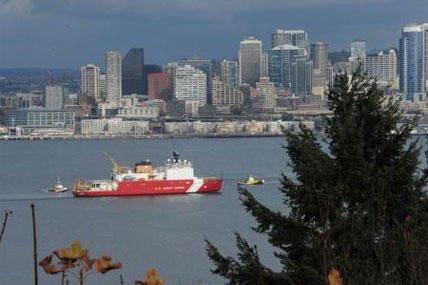SEATTLE – The Coast Guard Cutter Healy moored in Seattle Tuesday afternoon after completing 117 days underway for operations in the Bering Sea, Chukchi Sea, Beaufort Sea, and Arctic Ocean.
During that time, Healy’ crew of 88 successfully conducted three science missions and 1 Coast Guard missions to further the nation’s scientific knowledge of the Arctic.
The first science mission was a multidisciplinary study sponsored by the Bureau of Ocean Energy Management 90 miles west of Barrow, Alaska, near Hanna Shoal. Science members collected pelagic and benthic chemical and biological samples, observed physical oceanographic properties, and analyzed the data to establish an ecological baseline for the highly productive and biodiverse area. Equipment to measure Conductivity, Temperature, and Depth was used to collect water samples at different depths for physical and chemical properties of the ocean. Various net were also used to collect biological samples, and coring equipment to collect sediment and biological samples from the bottom of the ocean.
The second science mission was a study sponsored by the National Science Foundation (NSF) along the North Slope in the Beaufort Sea and in Canada’s Amundsen Gulf. The science party focused on identifying geological evidence of a massive flood near the Mackenzie River that occurred about 13,000 years ago and had profound effects on global climate. The science party used sonar to survey the seafloor to identify ideal areas to deploy the Jumbo Piston Core, an apparatus capable of sampling sediment 40-70 feet into the ocean floor. Similar to the rings of a tree, the science party will analyze the different layers of sediment retrieved during coring operations to learn about the water composition dating back thousands of years.
The third mission was sponsored by the Coast Guard Research and Development Center and took place near and in the ice pack. This mission’s focus was to assess the ability of current technologies to respond to oil spills in the Arctic. The technologies included an unmanned aerial system, an unmanned underwater vehicle, an oil recovery skimmer, and a remotely operated vehicle. Using oranges and peat moss to simulate an oil spill, the researchers observed how effectively the technologies surveyed and monitored recovery of the simulated spill.
The fourth science mission of the deployment was sponsored by NSF and took Healy north of Barrow on the North Slope and as far east as Amundsen Gulf. The primary mission objectives were to recover, service, and redeploy a series of scientific moorings anchored to the seafloor. Data collected by the instruments attached to the moorings documents the Western Arctic Boundary Current which helps improve the understanding of Arctic water current circulation.
The Healy, commissioned in 1999, is the nation’s newest and largest U.S. high latitude icebreaker. The cutter is 420 feet long and has extensive scientific capabilities. Homeported in Seattle, the cutter has a permanent crew of 88; its primary mission is scientific support. In addition, as a Coast Guard Cutter, Healy is capable of other operations such as search and rescue, ship escort, environmental protection, and the enforcement of laws and treaties in the Polar Regions.





















